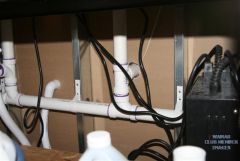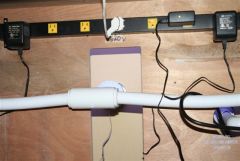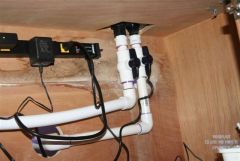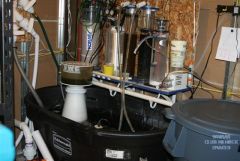-
Posts
21,554 -
Joined
-
Last visited
Content Type
Profiles
Forums
Gallery
Events
Store
Everything posted by Origami
-
From the album: Pics of my 180
-
From the album: Pics of my 180
-
From the album: Pics of my 180
-

overflow down a horozontal pipe, is it possible?
Origami replied to queloque's topic in Do It Yourself
I can get a picture, sure. A pump is not needed to get water to your sump if your sump is at a lower level than your display (as is almost always the case). You will have to have a pump, though, to return the water to your display. Can I ask how long you've been contemplating your setup? Have you visited any other reefers' house to see their setup? We have several members in Manassas and one popular LFS (local fish store), Blue Ribbon Koi, is right off 234 outside town (toward 15). The staff there could show you a little bit about how their system is configured to help give you a sense of how plumbing works. Let me take some pics.... -

overflow down a horozontal pipe, is it possible?
Origami replied to queloque's topic in Do It Yourself
As long as the water exits lower than it enters the pipe and the pipe is full of water (that is, as long as there's positive head pressure), you'll have flow by gravity. Some parts of my drainage runs around 10 (horizontal) feet. My display drains into a sump in the next room with about a 10' maximum horizontal run as well. Be aware that if you're pumping water back into the display from your garage-located sump, water will naturally flow into your overflow piping, thereby "pushing" water out into your sump. Where are you located? You may wish to consider listing your location in your profile. -
I like the new open look, Dave. Lot's of room for coral growth!
-
Ah, Forrest, but that's the question! We'll be waiting for another data point from you.... (What exactly are the two skimmers that you've now brought online? Post a picture of how you've got them staged as well - side by side vice series.)
-
I can't take credit for the crevice tool idea - my mom uses it - takes care of those pesky insects in a flash.
-

Anybody ever successfully re-sealed a glass aquarium?
Origami replied to steveoutlaw's topic in General Discussion
Came across this today, Steve, and thought of your reconstruction project: http://www.reefkeeping.com/issues/2009-04/...lides/index.php -
Vacuum him out with a crevice tool.
-
At the very most, a second skimmer will saturate the aqueous gas content in accordance with the ambient atmosphere (or air source for the skimmers). It will not lead to concentration in excess of what would constitute equilibrium. A second skimmer, if significantly different than the first might either effectively shut down or be shut down by the one performing at a higher level. At some point, the less efficient skimmer will be incapable of generating enough foam to carry pollutants up through the riser. Here's another aspect to the problem: There are also some people who believe that the composition of skimmate varies depending upon skimmer design. In this case, a second skimmer might actually lead to a more complete removal of pollutants. I'm not sure if I subscribe to this line of thinking, though, and mention it just because I've read it somewhere.
-
It's a standard 1-inch "slip" type bulkhead. Standard 1-inch schedule 40 PVC should easily fit it. You can get it at Lowes. You can cement a short bit of 1" pvc pipe followed by a 1" pvc barb adapter, or can follow the pipe with a threaded adapter and a threaded barb adapter. Either way will work. (BTW, standard 1-inch schedule 40 PVC pipe has an outside diameter of about 1.3".)
-
Lucky fishy. Forrest, if he hadn't escaped on his own, I would have suggested that you stop your pump and introduce air into the siphon tube part of the overflow. This would drop the water level in the part where the fish was trapped until he was lowered back into the main part of the box where you could net him.
-
I'm assuming that this "1.5 inch tube" is actually the threaded part of the bulkhead. Is that correct? If so, the threaded part on the outside is for the bulkhead nut. What's the inside of the bulkhead look like outside the overflow? If it's threaded, you probably have a slip-thread bulkhead. If it's not threaded, it's probably a slip-slip bulkhead. (I'm assuming that inside the overflow, you've got a slip - or unthreaded - connection.) Also, when you say "1.5" bulkhead," are you describing the bulkhead type or is it an actual measurement of the bulkhead that you've taken? I ask because a standard (light duty) 1-inch bulkhead is about 1.5" across on the outside. If you've got a 1-inch slip-slip bulkhead, you'll find that a piece of 1-inch PVC will slip right into the bulkhead (just like it was made to fit it). If it's a 1.5" bulkhead (slip-slip), you'll find that a piece of 1.5" PVC should fit. In either case (slip-slip or slip-thread), if you're going to connect to a piece of flexible tubing (not spa-flex or flex pvc), you're probably going to want a barb adapter in a size that matches the inside diameter of your tubing. You can find barb adapters in both slip- and threaded configurations at Lowes. If you've got a threaded connection to your bulkhead, you can use a threaded barb adapter right at the bulkhead if you want (personally, I like to put a valve in line so I can shut the overflow down if I need to). Use 3-5 wraps of teflon tape on the threaded joint to keep it from leaking. If you've got a slip connection on your bulkhead, you'll need to do some cementing but the connections are simple enough. The simplest connection sequence would be bulkhead=>pvc_pipe=>barb_adapter. Another option would be bulkhead=>pipe=>valve=>pipe=>barb_adapter. As David (dschflier) said, a picture of your bulkhead (maybe with a ruler so we can gauge the size) would be helpful.
-
ThatFishPlace.com is in the Allentown / Bethlehem, PA area. That helps get things here quickly. Have you checked with our local LFS' to make sure that they don't have what you need?
-

What is YOUR nana doing in the middle of the night?
Origami replied to lanman's topic in Marine Photography
OMG! It lives! -
Was the glass clean and free from debris or deposits around the seal area? Did you inspect the gasket and the inner (sealing) face of the bulkhead to make sure they were clean and smooth? Is there some major chipping around the hole that may have interfered with the seal setting properly? Sometimes I run a light coating of silicone grease (not sealant) on the gasket to allow it to compress evenly.
-
Here's mine. It's a 100 gallon stock tank. Maybe a little more than you want....
-
From the album: Pics of my 180
-
Absolutely. Sounds like a pretty large water change is in order to pull that ammonia reading down. Do you have some AmQuel on hand to help lock up some of that ammonia while you wait for the water? At 2 ppm, you're probably looking at cycling the tank again to regain your biological filtration. I suspect that a die-off of your sandbed's macrofauna is probably contributing to the spike now.
-
What kit were you using before. The new reading's much more reasonable.
-
darn, these things happen so quickly.... Good luck with the save efforts.
-
Do you use a reverse light cycle on your macroalgae fuge? Have you considered doing so? This helps to balance the nighttime respiration of photosynthetic organisms, spreading out the exhaled CO2. What's your max pH (just before the lights go out)?
-
Assuming the pH measurement is right, take a cup or two of water outside and aerate it for about 10 or 15 minutes. Compare the pH reading before and after aeration. If you see a substantial rise in pH, it's ambient CO2 (in the house) that's depressing your tank's pH and you may want to consider having your skimmer draw its air from a fresh (outside) air source. What is your alkalinity measurement anyway - what's "low acceptable"? Do you mean 2.5 meq/l? Here's a good low-pH article by RHF. http://www.reefkeeping.com/issues/2004-09/rhf/index.php






